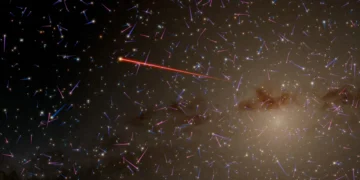Astronomers have discovered an extraordinary hypervelocity star system—one of the fastest-moving star systems ever recorded—racing through the Milky Way at an astonishing 1.9 million km/h (540 km/s). But what makes this discovery even more intriguing is the possible presence of an exoplanet orbiting this high-speed star. If confirmed, it would be the first known planet orbiting a hypervelocity star, challenging our current understanding of how planets form and survive in such extreme conditions.
What Are Hypervelocity Stars?
Hypervelocity stars are extremely fast-moving stars that have been ejected from their original locations due to powerful gravitational interactions. These stars often reach speeds exceeding the escape velocity of the Milky Way (600 km/s), meaning they can eventually leave the galaxy entirely.
- They are often caused by supermassive black holes, which can slingshot stars to tremendous speeds.
- Some are ejected due to supernova explosions or binary star disruptions.
- Most known hypervelocity stars do not have planets because their violent ejection would likely strip away any surrounding planetary bodies.
The newly discovered system, however, appears to defy this expectation.
Discovery of the Fastest Star System
The hypervelocity star system was first identified in 2011 using gravitational microlensing—a phenomenon where the gravity of a foreground object magnifies the light of a background star. Observations revealed a small star (about 1/5th the Sun’s mass) with an unseen companion roughly 29 times the mass of Earth, suggesting a super-Neptune or Jupiter-like exoplanet.
In 2021, follow-up data from ESA’s Gaia satellite pinpointed the system’s motion, revealing that it was traveling at an incredible 1.9 million km/h, making it one of the fastest-moving star systems ever recorded.
The microlensing method allows astronomers to detect planets indirectly by observing how their gravitational pull distorts the light from distant stars. However, because the technique does not measure exact distances, it leaves some uncertainties in mass calculations.
Why Is This Discovery Special?
This system challenges previous assumptions about planetary survival in high-speed environments. The presence of a planet orbiting such a fast-moving star raises key questions:
- How did the planet manage to stay gravitationally bound to the star?
- Did the star and planet form together, or was the planet captured during the star’s acceleration?
- Could such planetary systems exist elsewhere, even outside the Milky Way?
Alternative Theories: Could It Be a Rogue Planet With a Moon?
One alternative explanation is that instead of a star-planet system, what was observed could be a rogue planet with a large exomoon. This theory arises because:
- The exact distance to the system is not well-determined, making mass calculations uncertain.
- A giant rogue planet with a moon could produce similar microlensing effects.
- If this is the case, it would mark the first confirmed rogue exoplanet with an orbiting moon.
If the system turns out to be a rogue planet rather than a hypervelocity star with a planet, it could change our understanding of how free-floating planetary bodies travel through the galaxy. Rogue planets are believed to be ejected from their original star systems during planetary formation or close stellar encounters. Detecting a rogue planet with an exomoon would indicate that moons can survive even in such extreme environments.
Could This Star System Leave the Milky Way?
While current speed estimates suggest it is one of the fastest known systems, its total velocity is still under debate. If future data shows that it exceeds 600 km/s, it could be the first known star system on track to escape the Milky Way.
This raises fascinating implications:
- What happens to planets and stars that leave our galaxy?
- Could exoplanets survive intergalactic travel?
- Would this system become a “runaway planetary system” drifting into the intergalactic void?
Hypervelocity stars leaving the Milky Way provide clues about galactic dynamics, gravitational interactions, and the long-term fate of ejected planetary systems. If this system truly is on an escape trajectory, it could help scientists understand the mechanisms behind stellar ejections and intergalactic migration.
Next Steps: Confirming the Discovery
To confirm whether this system is indeed a hypervelocity star with an exoplanet, astronomers plan to:
- Conduct high-resolution imaging to track the system’s movement over time.
- Use Gaia’s future data releases to refine its velocity and trajectory.
- Analyze its chemical composition to determine if it originated in the Milky Way’s core or was ejected from another galactic region.
- Compare its motion to existing simulations of hypervelocity systems to determine whether it is likely to leave the Milky Way.
Additionally, planned infrared and spectroscopic observations may help determine the composition and atmospheric properties of the suspected exoplanet. If it truly is a super-Neptune, it could provide valuable insights into the evolution of gas giants under extreme conditions.
Conclusion: A Revolutionary Discovery in Astrophysics
This record-breaking star system represents a groundbreaking step in the study of high-speed celestial objects and planetary systems. Whether it turns out to be a hypervelocity star with a planet or a rogue planet with a moon, this discovery expands our understanding of extreme astrophysical phenomena.
Reference:
A Candidate High-velocity Exoplanet System in the Galactic Bulge



















